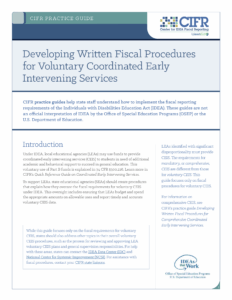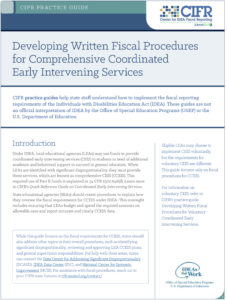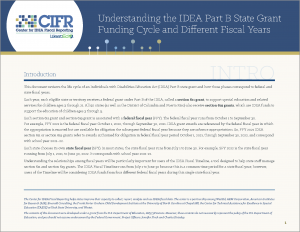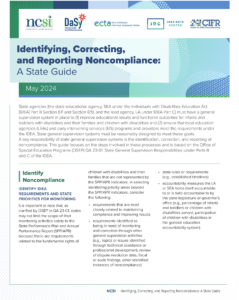This resource library makes it easy to find IDEA fiscal information within CIFR’s focus areas, including key resources for new state staff. Enter search terms or use the filters at left to narrow the list.

IDEA Part B Fiscal Timeline 1.5
This popular planning tool helps SEA staff manage and monitor the work they need to do to meet the fiscal requirements of IDEA.

From Data to Action: Using IDEA Fiscal Data
Use IDEA fiscal data to inform state technical assistance, policies, and practices with the questions in this online resource.

IDEA Part B Maintenance of Effort (MOE) Reduction and Coordinated Early Intervening Services (CEIS) File Specifications
This document contains instructions for building files to submit IDEA Part B Maintenance of Effort (MOE) Reduction, Coordinated Early Intervening Services (CEIS), and Comprehensive CEIS (CCEIS) data.

Developing Written Fiscal Procedures for Voluntary Coordinated Early Intervening Services
This guide helps states create or improve procedures for managing IDEA Part B fiscal requirements for voluntary CEIS, providing sample language and guiding questions for key components.

Developing Written Fiscal Procedures for Comprehensive Coordinated Early Intervening Services
This guide helps states create or improve procedures for managing IDEA Part B fiscal requirements for comprehensive CEIS, providing sample language and guiding questions for key components.

Understanding the IDEA Part B State Grant Funding Cycle and Different Fiscal Years
This document reviews the life cycle of an Individuals with Disabilities Education Act (IDEA) state grant and how that cycle corresponds to federal and state fiscal years.

EDFacts Edit Check Tool – EMAPS IDEA Part B MOE Reduction and CEIS Survey
This tool was developed by the IDEA Data Center (IDC), in collaboration with CIFR, to help states prepare their Part B MOE and CEIS data submission. States can use the tool to identify potential edit check errors or errors in subtotals or totals prior to submitting the data to OSEP.

EMAPS User Guide: IDEA Part B Maintenance of Effort (MOE) Reduction and Coordinated Early Intervening Services (CEIS)
This user guide is intended to provide assistance to users of the EDFacts Metadata and Process System (EMAPS) for the IDEA Part B MOE reduction and CEIS reporting requirements. It demonstrates the steps necessary to enter the data and navigate in EMAPS. In Fall 2025, the LEA MOE/CEIS data collection will migrate from EDFacts to EDPass.

Identifying, Correcting, and Reporting Noncompliance: A State Guide
A key responsibility of state general supervision systems is the identification, correction, and reporting of noncompliance. This guide focuses on the steps involved in these processes and is based on the Office of Special Education Programs QA 23-01: State General Supervision Responsibilities Under Parts B and C of the IDEA.

Part B Significant Disproportionality Protocol
In 2024, this protocol was implemented as part of OSEP’s Differentiated Monitoring and Supports (DMS) to ensure that states properly monitor significant disproportionality within their LEAs.

